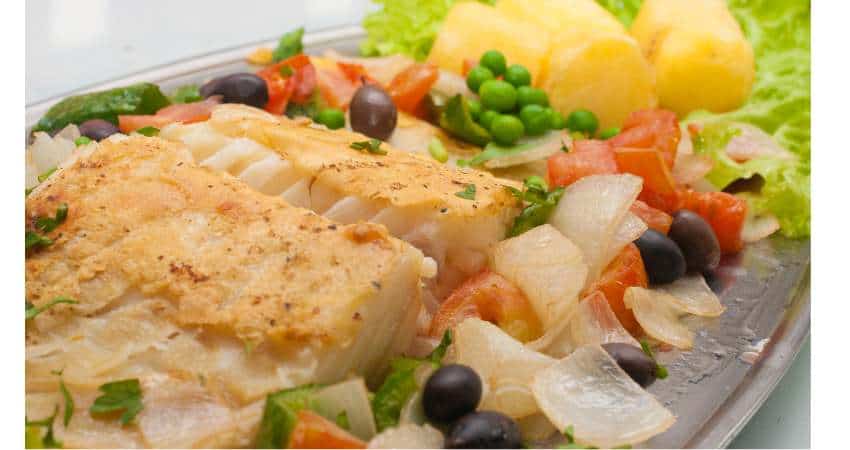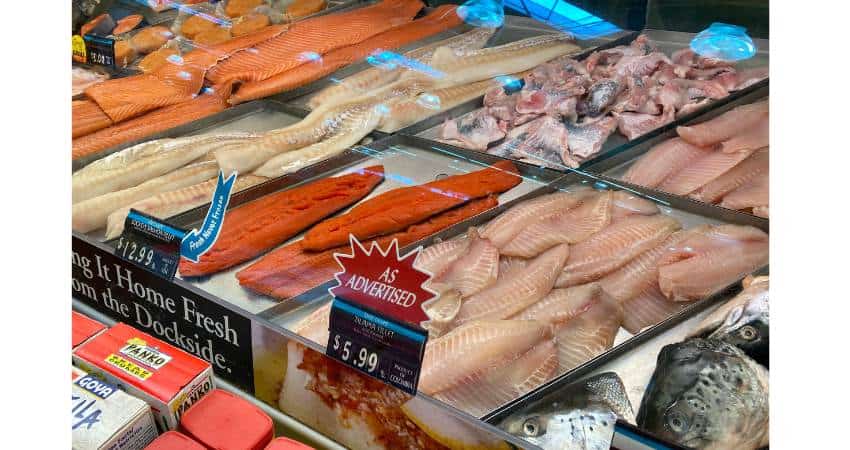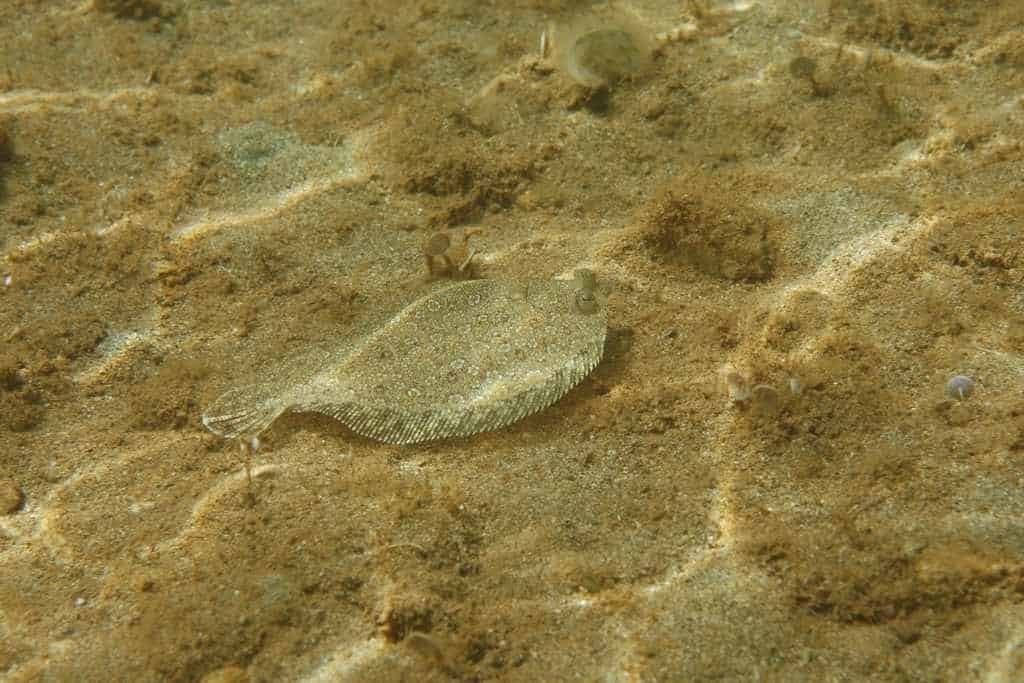Flounder vs Cod: Is One Better? Let’s Compare
Flounder and cod are both nutritious and popular. Due to this, it may not be easy deciding which one you’d like for your next meal. It may help to answer the question, what is better flounder or cod?
Cod is better than flounder because it contains more protein, less fat and a higher percentage of vitamins. It contains a larger number of B vitamins, potassium, magnesium and zinc. Cod has a firmer texture allowing it to be used in more cooking methods. It is more affordable due to its lower price.
This article will examine all the differences between the two fish including a side-by-side nutrient comparison. In addition, I’ll compare their textures, tastes, costs, mercury levels and whether one can substitute for the other.
As a Certified Health Coach, many of my clients ask me about fish. In addition to coaching clients about flounder and cod, I’ve purchased, researched and consumed both fish for over 20 years.

Flounder vs Cod: Nutrition Comparison
The table below is a nutrient comparison between the two fish per four ounces.
| Nutrient | Cod, raw (4 Ounces) | Flounder, raw (4 Ounces) |
| Calories | 93 | 79 |
| Fat | 0.8 g | 2.2 g |
| Protein | 23 g | 14 g |
| Omega-3 | 0.22 g | 0.31 g |
| B-6 | 0.2 mg | 0.1 mg |
| B-12 | 1.0 mcg | 1.2 mcg |
| Thiamin | 0.08 mg | 0.02 mg |
| Riboflavin | 0.07 mg | 0.02 mg |
| B5 | 0.1 mg | 0.4 mg |
| Iron | 0.4 mg | 0.2 mg |
| Niacin | 2.3 mg | 1.1 mg |
| Folate | 7.9 mcg | 5.6 mcg |
| Potassium | 468 mg | 181 mg |
| Magnesium | 36 mg | 20 mg |
| Phosphorus | 230 mg | 285 mg |
| Calcium | 18.1 mg | 23.8 mg |
| Zinc | 0.5 mg | 0.3 mg |
| Selenium | 37.5 mcg | 30.2 mcg |
Nutrient source: Nutrition Value1 ((Nutrition Value: Fish, raw, Atlantic, cod))
The table above compares the major nutrients, minerals and vitamins side-by-side. After examining the numbers above, it’s difficult to decide which fish, flounder vs cod, is healthier.
Cod is healthier than flounder due to its larger number of vitamins and minerals. It contains less fat while providing more protein. Cod contains more B6, thiamin, riboflavin, iron, niacin, folate, potassium, magnesium, zinc and selenium.
Flounder contains a wide variety of nutrients, just less numbers of each one. It contains slightly more omega-3 fatty acids, B12, B5, phosphorus and calcium than cod2.
Which to Choose?
Weight Loss
Flounder is better for weight loss than cod due to its 14 fewer calories per four ounces. Flounder contains 79 calories while cod has 93.
Bodybuilding and Muscle
Cod fish is better for bodybuilding and building muscle than flounder fish due to its higher percentage of protein and calories. Cod’s 64% more protein helps to repair, build and maintain muscle mass.
Cod fillet is more calories than in flounder helping to achieve more weight while in a bulking phase of building muscle mass.
While shopping I’ll choose the cod more often due to its nutrients and availability.
Flounder Fish and Cod Health Benefits
Omega-3 Fatty Acids
Flounder provides a little more of heart healthy omega-3 fatty acids. Omega-3 fatty acids are heart healthy and help keep cholesterol levels lower and arteries healthy.
Two of the fatty acids, DHA and EPA are associated with lowering blood pressure and improving the health of blood vessels ((National Center for Biotechnology: Marine Omega-3 Supplementation and Cardiovascular Disease)).
They help keep the blood vessels healthy by reducing inflammation, plaque build-up, triglycerides and can help keep the heart rhythms more normal.
Studies suggest omega-3s can help reduce joint pain and stiffness in people with rheumatoid arthritis. They may also boost the effectiveness of anti-inflammatory drugs.
Both fish are high in healthy fats.
I recently wrote an article comparing black cod. If you’re interested in how many omega-3s they contain or just want to learn about them, check out my article, Black Cod – Is There A Difference?

B Vitamins
Both fish contain many B vitamins. These include B6, B12, B5, B1 (thiamin), B2 (riboflavin), B3 (niacin) and B9 (folate). Vitamin B helps to support the following:
- Digestion
- Red blood cells
- Brain function
- Energy levels
- Nerve function
- Cardiovascular health
Magnesium
Both fish contain magnesium. Adding magnesium to your diet could be instrumental in improving sleep quality. More so, it helps keep blood pressure levels balanced and stable ((National Institutes of Health: Magnesium)).
Magnesium relaxes and calms the whole body including the blood vessels. A recent study researched 22 studies and concluded magnesium supplementation decreased systolic and diastolic blood pressure3.
Calcium
Both fish provide a similar amount, flounder slightly more. Calcium, like magnesium is important for blood pressure and the heart. Harvard Health reports calcium helps maintain blood pressure because it helps to control the relaxing and tightening of blood vessels4.
Potassium
Cod fish contains almost 500 mg of potassium beneficial for reducing sodium intake. It helps the body reduce fluids and rids excess sodium ((American Heart Association: How Potassium Can Help Control High Blood Pressure)). This process helps to reduce blood pressure.
Cod and Flounder Taste and Texture
Flounder tastes mild and slightly sweet. Its texture is fine and delicate with low levels of oiliness. It is more flakier and can fall apart easier while cooking.
Cod has a mild, milky flavor. Atlantic cod may be slightly sweeter than Pacific cod. Many people say the texture is similar to chicken due to its firmness. It has large flakes and is good for various cooking methods.
Since flounder is a good fish to eat, I conducted original research on taste and flavor by polling my health coaching clients, readers and people in food groups I belong to. I asked which fish tastes better?
- 53% said they preferred the cod.
- 47% said they preferred flounder.
I then set up a blind taste test at my home. Both fish were seasoned and cooked the same exact way. Three out of four people chose the cod.
What about cod vs tilapia? Check out the battle of these heavyweights in my article here, Tilapia – A Complete Comparison.
Can You Substitute Flounder for Cod?
Sometimes you won’t have the exact fish for a recipe, or the seafood section of the supermarket doesn’t have the fish you need. Especially flounder which is the more difficult fish to find.
Cod can substitute for flounder due to their similar mild to sweet tastes. It has a firmer texture and doesn’t fall apart as easily as flounder making it okay to use for various cooking methods.
Flounder taste can substitute for cod’s similar mild to sweet tastes. If grilling, flounder can’t substitute because the flesh falls apart easier. Flounder can substitute when frying, poaching, broiling and baking.
Good substitutes for cod include:
- Pollock
- Haddock
- Halibut
- Striped bass
- Tilapia
- Mahi mahi
Good substitutions for flounder include the following:
- Halibut
- Tilapia
- Branzino
- Cod
- Rainbow trout
- Butterfish
Both of the fish are white fish so the color will be similar when substituting.
When substituting one fish for the other always stick to the following:
- Same fish size and weight.
- Stick with similar fillets, whole fillet or cross section.
- Stick with skinless or skin when the recipe calls for one type of fish.
- Texture is more important for certain cooking methods. Like using a firmer texture when grilling fish5.

Mercury Levels
The FDA and the EPA have warnings and suggestions regarding mercury levels in fish and how often to consume them6. This is especially important for pregnant women, breastfeeding or for young toddlers and infants.
They established a list of best choices, good choices and fish to avoid based on their mercury levels.
Flounder and cod contain similar mercury levels. They are listed on the FDA’s best choices in regards to mercury levels.
Always check with a physician prior to eating new fish, foods, changing your dietary habits and how often to consume certain fish. Certain fish are limited per week depending on their levels.
The Costs
The cost of either fish will differ depending on the location, fresh or frozen and whether the fish is farm raised or wild caught. Let’s determine which fish costs more.
Flounder is more expensive than cod. The average cost for cod is $12.99 per pound while the average cost for flounder is $14.49 per pound. The cost will vary depending on location, whether it is farm-raised or wild-caught, fresh or frozen.
I conducted original research on costs by visiting various stores and checking the prices of both white fish.
First, I checked Freshdirect for the current prices of each fish.
- Fresh, wild caught flounder fillets
- $17.99 per pound
- Fresh, wild caught cod
- $16.99 per pound

I checked the local Shopright supermarket and found the following fish prices:
- Fresh wild caught Alaska cod fillet
- $8.99 per pound
- Fresh wild North Atlantic cod fillet
- $12.99 per pound
- Fish wild North Atlantic flounder fillet fish
- $10.99 per pound
The availability of flounder will be more difficult to find in your local supermarket. You’d have a better chance finding it in a local fish market or fish store online.
Differences Between Flounder, Pacific Cod and Atlantic
Let’s take a detailed look at the differences between the two fish.
Flounders are a group of flatfish species living and feeding on the bottom of oceans. Cod is from the Gadidae family and can be found in the Atlantic and Pacific oceans. Flounders are typically brown with colored markings while cod is brownish with dark spots. Cod is larger but doesn’t live as long.

Habitats
Atlantic cod is found in the Northwest Atlantic Ocean from Greenland to North Carolina and in the western Gulf of Maine. Pacific cod is found in the North Pacific Ocean from the Bering Sea to California in the east and to the Sea of Japan in the west.
The gulf, southern, summer and winter flounders are found in the western Atlantic Ocean. The European and witch flounders are found in European waters. The olive flounder can be found swimming in the North Pacific Ocean.
Colors
- The color of the flounder depends on the habitat. Flounders are typically brown colored with various red, orange, green and blue markings on the body.
- Cod is brownish with dark spots.
Appearance
- Flounder has an oval, flattened body with bulging eyes both located on one side of the head.
- Cod is the typical long, narrow body shape and has three dorsal fins.
Size and Weight
- Flounder grows 12-36″ in length and weighs 3-11 pounds.
- Cod grows an average 27-34″ in length and weighs 5-15 pounds.
Age
- Flounder up to 27 years.
- Cod up to 12 years.
Depending on the species of flounder, both of their eyes will be on the right or left side of the head. The following are some flounder species and what side of the head the eyes are located on:
- Arrowtooth flounder – Right eyed, meaning both eyes are on the right side of the head.
- Windowpane flounder – Left eyed.
- Witch flounder – Right eyed.
- Yellowtail flounder – Right eyed.
- Winter flounder – Right eyed.
- Summer flounder – Left eyed.
If you have any questions about this article or other posts, don’t hesitate to email notify us. You can find an email on our contact page. We’ll do our best to reply as soon as possible.
Read Next – More Cod vs Fish Articles!
Blue Cod Vs Cod – A Complete Comparison
Halibut vs Cod: The Differences In Detail
Scrod vs Cod: There’s More To The Story
- Nutrition Value: Flounder, raw [↩]
- NOAA Fisheries: Pacific Cod [↩]
- National Center for Biotechnology Information: Effect of magnesium supplementation on blood pressure: a meta-analysis [↩]
- Harvard Health: Key minerals to help control blood pressure [↩]
- Sea Grant North Carolina: Fish Flavors and Substitutions [↩]
- FDA: Advice about Eating Fish [↩]
